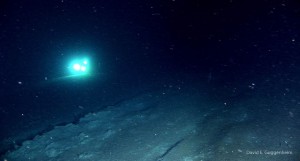The Worst Thing I Ever Saw Underwater (and Why it Matters This Week)

An enormous scar on the bottom of the Bering Sea’s Pribolof Canyon at 1,000 feet left by a trawl net leaves a path of destruction miles long, having ripped corals, sponges and everything else in its path from the bottom. (Photo: D. Guggenheim)
On Friday, August 3rd, 2007, I landed the Deepworker submersible at 1,052 feet in the second largest underwater canyon in the world, Pribilof Canyon in Alaska’s Bering Sea. In the distance, I saw the lights of the other submersible, piloted by Michelle Ridgway.
As we both sat on the bottom conducting life support checks and communicating with the Greenpeace ship, Esperanza above, I peered through the dome and saw something strange. I reported that I had landed on what appeared to be some sort of geologic stratification — unusual layers and grooves of sediment in parallel lines across my path. What in the world was this? We hadn’t seen anything like it. Read more


